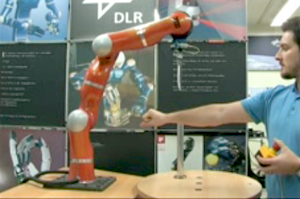Project 2 – Gray Lit from Zack
I recently found a National Geographic article titled “Us, and Them”, about making robots part of the everyday world and found it to be particularly informative regarding feelings toward “social” robots vs/ industrial robots. I hope that my class project addresses these preconceived notions in a provocative way. The most relevant sentence:
“Traditional robots, the kind you might find spot-welding a car frame, can be programmed to carry out a very precise sequence of tasks but only within rigidly structured environments.” (pg3 ¶ 6 of the attached PDF)
The bulk of the article references research here, at CMU.
↔↔↔↔↔↔↔↔↔↔↔↔↔↔↔↔↔↔↔↔↔↔↔↔↔↔↔↔↔↔↔↔↔↔↔↔↔↔↔↔↔↔↔↔↔↔↔
SECOND VIDEO IS A MUST SEE!
UPDATE: It turns out that the courageous individual in the video is Sami Haddadin, the study’s lead author, who was clearly confident in the collision-detection system he devised. I incorporated additional details he gave me.
The idea of a robot in the kitchen cooking us meals sounds great. Just watch out when the automaton is handling the knives!

They fitted an articulated robotic arm with various tools (scalpel, kitchen knife, scissors, steak knife, screwdriver) and programmed it to execute different striking maneuvers. They used a block of silicone, a pig’s leg, and at one point a human volunteer’s bare arm as the, uh, test surface.
The researchers — Sami Haddadin, Alin Albu-Schaffer, and Gerd Hirzinger from theInstitute of Robotics and Mechatronics, part of DLR, the German aerospace center, in Wessling, Germany — presented their results today at the IEEE International Conference on Robotics and Automation, in Anchorage, Alaska.
The main goal of the study was to understand the biomechanics of soft-tissue injury caused by a knife-wielding robot. But the researchers also wanted to design and test a collision-detection system that could prevent or at least minimize injury. Apparently the system worked so well that in some cases the researchers were willing to try it on human subjects.
We applaud the guy [editor’s note: see update above] at the end of the video who put his body on the line in the name of robotic science.
Warning: Some people may consider content graphic or upsetting.
The researchers acknowledge that there are huge reservations about equipping robots with sharp tools in human environments. It won’t happen any time soon. (Sorry, you’ll still have to chop that cucumber salad yourself). But they argue that only by getting more data can roboticists build safer robots.
The experiments involved the DLR Lightweight Robot III, or LWRIII, a 7 degrees-of-freedom robot manipulator with a 1.1 meter reach and moderately flexible joints. The robot, which weighs 14 kilograms, is designed for direct physical interaction and cooperation with humans.
The tools the researchers tested included [photo, right]: (1) scalpel; (2) kitchen knife; (3) scissors; (4) steak knife; (5) screwdriver.
The researchers performed two types of experiments: stabbing and cutting, testing the different tools striking at various speeds, with and without the collision-detection system active.
In most cases, the contact resulted in deep cuts and punctures, with potentially lethal consequences. But remarkably, the collision-detection system was able to reduce the depth of the cuts and in a few cases even prevent penetration altogether.
Although the robotic arm has a force-torque sensor on its wrist, this sensor is not used in the collision-detection system; it only serves as a measurement reference in the experiment. “The collision detection and reaction,” Haddadin told me, “is based on a very good dynamics model of the robot and the fact that, unlike other robots, we have torque sensors and position sensors in every joint.”
With the dynamics model (which includes rigid body dynamics, joint elasticity, and motor model) and the sensor measurements, the robot can detect a collision nearly instantaneously. (The control system relies on a “nonlinear disturbance observer.”)
“This method does not require any additional external sensors and only relies on the internal capabilities of the robot,” says Haddadin.
This is the first study to investigate soft-tissue injuries caused by robots and sharp instruments. Previous studies by the same researchers, as well as other groups, have focused on blunt collisions involving non-sharp surfaces.
The video below shows impact experiments using crash-test dummies and large industrial robots. Ouch.
Another related project but not based on touch feedback, and too weird to take seriously…

